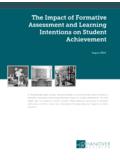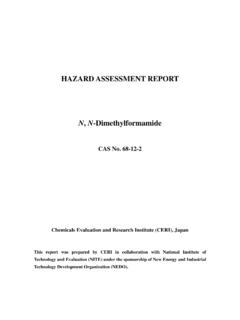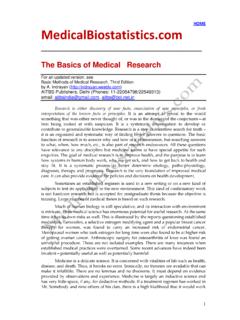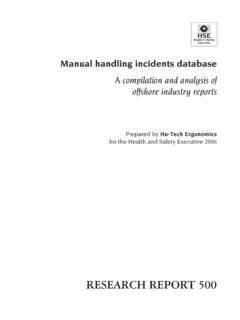Transcription of Offshore hydrocarbon releases 2001-2008 RR672
1 Executive Health and Safety Offshore hydrocarbon releases 2001-2008 Prepared by the Health and Safety Laboratory for the Health and Safety Executive 2008 RR672 Research Report Executive Health and Safety Offshore hydrocarbon releases 2001-2008 Alison McGillivray & John Hare Health and Safety Laboratory Harpur Hill Buxton Derbyshire SK17 9JN The Offshore industry employs about 28 000 personnel involved in a wide range of activities. Since the Piper Alpha disaster in 1988, health and safety issues concerning Offshore platforms have vastly reduced, however, the work practices involved are not risk free and still have the potential to cause considerable loss of life when things go wrong. Increases in oil prices, declining reserves and an ageing infrastructure have resulted in increased drilling activity around marginal fields.
2 Operators have looked for new ways in which to cut costs, which could affect the health and safety of the workforce. HSE s Major Hazards Strategic Programme Plan outlined targets that hope to reduce the number of major and significant releases from the 2001/02 baseline of 113 to 67 by the end of 2006/07 (10% year-on-year reduction) and to 60 by the end of 2007/08 (10% year-on-year reduction). However, in recent years there has been an increase in the number of major and significant hydrocarbon releases on Offshore platforms that require investigation. This work hopes to identify the immediate cause of hydrocarbon leaks, and determine if there are discernable reasons for the increasing trends. Two databases currently used by HSE when dealing with Offshore releases were utilised, namely the hydrocarbon release (HCR) and RIDDOR databases.
3 Cross-referencing between the two catalogues was expected to yield complete information including platform location, release size and type, as well as possible failure causes. When brought together over a range of different releases , this information can generate an overall picture of issues related to increasing release frequency. Once an analysis had been completed, areas that require improvement, such as structural limitations, system and equipment faults as well as failings in procedural and operational methods, were indicated where possible. This report and the work it describes were funded by the Health and Safety Executive (HSE). Its contents, including any opinions and/or conclusions expressed, are those of the authors alone and do not necessarily reflect HSE policy. HSE Books Crown copyright 2008 First published 2008 All rights reserved.
4 No part of this publication may be reproduced, stored in a retrieval system, or transmitted in any form or by any means (electronic, mechanical, photocopying, recording or otherwise) without the prior written permission of the copyright owner. Applications for reproduction should be made in writing to: Licensing Division, Her Majesty s Stationery Office, St Clements House, 2-16 Colegate, Norwich NR3 1BQ or by e-mail to ii ACKNOWLEDGEMENTS The authors wish to thank Kevin Quinn and Chris Mawdsley for their help in accessing the appropriate databases. iii iv CONTENTS 1 2 HCR Database ..2 RIDDOR 3 hydrocarbon releases Yearly and monthly release release trends in relation to process release trends in relation to release trends in relation to platform release trends in relation to system Other 4 hydrocarbon release ANALYSIS.
5 15 Partial data ..15 Full Overall analysis ..26 5 REVIEW OF OTHER RELEVANT STUDIES / OSD hydrocarbon release reduction Loss of containment Assessment of the major accident hazard aspects of safety 6 Comparison with hydrocarbon release reduction campaign ..39 Comparison with loss of containment manual ..39 Comparison with GASCET ..40 7 CONCLUSION AND 8 APPENDIX A SEVERITY CLASSIFICATION ..44 9 APPENDIX B release CAUSES PER YEAR ..47 10 APPENDIX C releases IN TERMS OF AGE OF Further investigation Flanges ..51 Further investigation Further investigation Internal corrosion ..53 Further Investigation Normal Further investigation Mechanical fatigue ..54 11 APPENDIX D release CAUSES PER Further investigation Start up.
6 58 v 12 APPENDIX E release CAUSES FOR EACH PROCESS 13 14 15 vi EXECUTIVE SUMMARY Objectives To utilise the hydrocarbon release (HCR) and RIDDOR databases in order to identify the main causes of major and significant releases between 2001 and 2007. The analysis should also highlight possible reasons to explain why the number of these releases has been increasing over recent years, and follows on from previous work [1]. Main Findings The main findings, based on the sum of significant and major releases , are: The total annual number of releases has decreased over the study period. However, this decrease is due mainly to the reduction of significant releases , as major releases have stayed fairly constant in number; Typically, the number of releases peaks during November, April and August, and experiences corresponding troughs during May, June, January and September.
7 The releases per month may be influenced by plant intervention high interventions in summer and low in winter; Gas releases are the most common followed by oil, non-process and 2-phase (which are tied) and lastly condensate; Older platforms aged 20 years and over experience the most releases ; releases from installations in most age ranges seem to be decreasing over time except the 10-15 age range which seems to be increasing; Comments on the full set of major and significant releases were: Gas compression is the system that results in most releases , then export, then utilities; Piping is the most common equipment type that experiences releases , then instruments, then flanges; The most frequent equipment failure cause is mechanical failure, then none, then mechanical fatigue.
8 Note that the subgroup failure is a default under mechanical causes of releases and may include some cases of fatigue or wear-out not adequately described in the Form OIR12; Incorrectly fitted equipment is the most widespread operational cause that is explicitly stated, then improper operation human factors issue. None appears most frequently; Non-compliance with a procedure is the most common procedural cause that is explicitly stated, then deficient procedure human factors issue. None appears most frequently; Most releases occur in the normal production operational mode, followed by start up and reinstatement. vii Main causes per year: The number of releases for each category is either roughly consistent, or reducing in number with time.
9 With all causes, except releases due to system failure, the number of blank inputs has increased in later years, particularly between 2005 and 2007. This is mainly due to the manner in which the release reports are recorded, so it may be worthwhile checking why these areas have been left blank. There seemed to be no major issues relating to the year. Age of platform: The oldest platforms at 20+ years have the most instances of releases for export and utilities systems, perhaps confirming the importance of management of ageing installations. Relatively new platforms, between 5-10 years of age at the time of release , account for the most gas compression system releases . In fact, these platforms have high numbers of releases in general when compared to the surrounding platform ages, so it may be useful to investigate the issues surrounding these installations.
10 Considering the equipment, piping is an issue with installations aged 20+, this suggests an issue with the management of ageing installations. releases concerning flanges are fairly common with installations aged 5-10 years. Ring Type Joint (RTJ) flange joints are the most troublesome, again with 5-10 year old platforms and usually with smaller diameter flanges. This may be due to the population of smaller sized flanges on installations. Mechanical failure is the most common equipment cause for releases . There are a significant number of mechanical fatigue releases , again with platforms aged 5-10 years at the time of release . Internal corrosion also causes a significant number of releases for platforms aged 20+ years compared with smaller numbers for other ages.

















